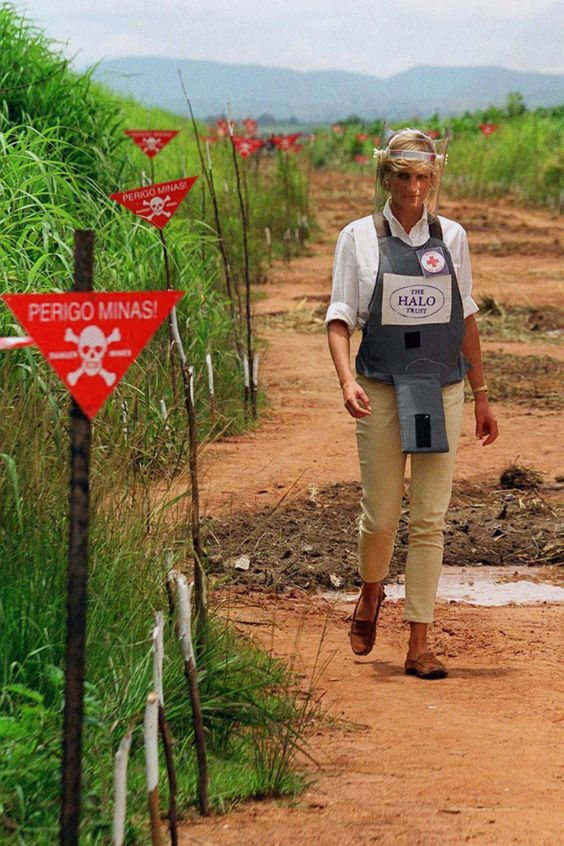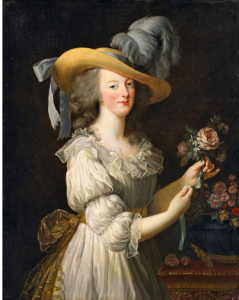Picture a princess. What image comes to your mind? Something out of a Disney movie, right? Carriages, designer dresses, star-studded balls, and monumental weddings are some of the aspects that depict the mainstream image of royalty. Now picture a princess…in a war zone. In early 1997, Princess Diana of Wales found herself standing beneath the pungent Angolan sun, away from the luxuries and gala events, where she cast off her royal attire for protective body armor and a visor. Princess Diana of Wales shed a momentous light on one of the most unnoticed atrocities of the African continent: landmines. That single action of hers, on that day, still resonates for us today, long after her untimely death.
Darkness had fallen on the lives of many innocent African communities. As disputes between villages turned into wars, public areas were replete with tragedy and death. In the mid-1990’s, three-dollar weapons called landmines were terrorizing the innocent—claiming twelve thousand civilian lives and causing the highest number of amputees in the world. Landmines are placed during these armed disputes, concealed underground to destroy or disable enemy targets.1 Although the armed combats in Angola had ended, the war “debris” continued to threaten people’s safety. People were dying regularly from leftover landmines, but few outside Angola knew anything about them. These mines would remain “live” for years, even decades, waiting for unsuspecting victims, as per their design, causing unimaginable suffering and pain.2

The African people were in desperate need of a solution. They needed a defender. Their cry for help was heard, reaching the gates of Kensington Palace. It was none other than Princess Diana—keen philanthropist and self-proclaimed Queen of Hearts—whose life purpose had become to shed a humane light on controversial issues such as AIDS and homelessness. “I’d read the statistics that Angola has the highest percentage of amputees anywhere in the world. That one person in every 333 had lost a limb, most of them through land mine explosion.”3 The moment Princess Diana became aware of this neglected tragedy, she knew exactly what she needed to do: take immediate action. “I have all this media interest, so let’s take it somewhere where they can be positive and embrace a situation which is distressing like this.”3 In early January 1997, she flew to Angola along with the Red Cross and a BBC camera crew.
A fearless Diana put herself in the midst of one of the most dangerous places in the world, thousands of miles away from the royal guard, protected solely by a riot helmet and a flak jacket given to her. Accompanied by local anti-landmine activists, she was taken to see a land-mine clearing operation in Huambo, central Angola.5 This was a royal, who spent a large part of her life in luxurious settings being served by others, who was personally stepping into filthy fields to deactivate mines, serving those whose lives were shattered by the deadly weapons. As she pushed the button to detonate a single mine, she uttered the words “One down, 17 million to go.”6

After the cameras stopped rolling, Diana didn’t. The fight to ban antipersonnel landmines became a personal crusade, one that would fill the last year of her life.7 She made this clear in the last speech she ever delivered, stating, “The more expeditiously we can end this plague on earth caused by the landmine, the more readily can we set about the constructive tasks to which so many give their hand in the cause of humanity.”8 This public light shed by Diana brought nothing but success, influencing countries to come together to pledge millions of dollars to tackle the destruction caused by landmines, as well as bringing 122 governments from around the world to contribute to the passage of the Ottawa Mine Treaty. Landmines are still an issue of global concern, but Diana remains the most influential face of anti-landmine activism.
- Isebill V. Gruhn, “Land Mines: An African Tragedy,” Journal of Modern African Studies, no. 4 (December 1996): 688. ↵
- Stuart Maslen, Mine Action after Diana: Progress in the Struggle Against Landmines (London: Pluto Press, 2004), 15. ↵
- Heart of the Matter: Diary of a Princess, directed by Karina Brennan (UK: BBC, 1997). ↵
- Heart of the Matter: Diary of a Princess, directed by Karina Brennan (UK: BBC, 1997). ↵
- Encyclopedia of Espionage, Intelligence and Security, 2004, s.v. “Unexploded Ordnance and Mines,” by Mike Lambert. ↵
- Johnna Rizzo, “How Princess Diana Crippled The Case For Land Mines,” Newsweek, Oct. 24, 2015. ↵
- Johnna Rizzo, “How Princess Diana Crippled The Case For Land Mines,” Newsweek, Oct. 24, 2015. ↵
- Diana, Princess of Wales, “Responding To Landmines: A Modern Tragedy And It’s Consequences” (keynote address, Mines Advisory Group and the Landmine Survivors Network, London, June 12, 1997). ↵



82 comments
Luisa Ortiz
One more reason to love and respect Princess Diana is for the sole reason that she is an icon in everything she does! I was aware of her involvement with organizations and other people around the world; she is a true inspiration of empowerment, loving and a caring public figure. This article showcases her love and cares for others, who are more oppressive and don’t have a strong voice! Good job on this article!
Rebecca Campos
I’ve seen multiple documentaries and read articles the very famous Princess Diana, but never had I read about her being the face of anti-landmine activism. This article did a good job at showing a different side of Princess Diana that many people may not know. Princess Diana was very different from the royal stereotype in that she was willing to get her hands dirty and this type of work is the absolute last thing you expect a princess to do. It’s even more interesting that this topic was mentioned in the last speech she ever gave implying the truth importance and priority this issue had in her life.
Janelle Larios
Princess Diana was such a beautiful and non-conforming princess. She broke so many rules that are put on royalties and because of this it has made her the princess that the common people could relate to. This article is just another thing that you can tack onto her list. She cared for society, in and out of her social class and she tried her best to use the media power she knew she had to shine light on disheartening situations all over the world. I didn’t know that she did this, but it only makes be respect her more.
Daniela Martinez
I have long been a fan of the royal family, I loved being able to watch Prince Williams wedding and more recently Prince Harry’s wedding with Magan Markle. However, I was not aware of the fact that their mother took part in advocating for the people in Africa who had been affected by landmines. This comes to show that not all royals are just attending fancy events but that some are involved in doing serious work and bringing attention to serious events. Through this article, I was able to learn a different side to Princess Diana and the devastating effects that many of the people in Africa experienced by the remaining landmines.
Nathan Hartley
I don’t read a lot of news article involving other countries, so seeing the princess of a nation doing work like this caught my eye. My grandma was from England, and during WWII the guns in her town that stopped German bombers shattered every window in her house. Her family also paid for a bunker themselves because the government couldn’t provide one. I think it is very good to see these trends changing as the people receive more help and can live less afraid of the effects of that terrible war.
Hanadi Sonouper
Princess Diana was such a loved and respected woman around the world, not only was she embraced by her warm charm and charisma, but her humanitarian relief. Before reading this article, I was not aware of her involvement with other countries like this particular one in Angola. She was indeed an inspiring woman, who wanted to do much more with her life than just portray the role of a princess, she wanted to showcase and highlight real world situations that the common media source strives away from. She did so much with her life and inspired many, it was a shame that her life was cut short, she would have been able to inspire many more people with her platform today.
Maria Esquivel
Princess Diana will always be a motivation to many people. The influence she had over these African communities shows how she genuinely cared for others and wanted change for the better. That the work she did was because she believed in helping others and not for publicity. This article describes Princess Diana perfectly and explains the landmine troubles that many African communities still have to deal with. This was an incredible, well written article!
Vanessa Tombo
Prior to reading this article, I was unaware of how and why Princess Diana brought 122 governments worldwide to help pass the Ottawa Mine Treaty. She was able to use her influence to help the lives of those who have been neglected and forgotten by their own unstable governments. This article sheds light on the life of Princess Diana, it allows readers to view her from a different perspective.
Vanessa Tombo
Prior to reading this article, I was unaware of what Princess Diana to help bring 122 governments worldwide to help pass the Ottawa Mine Treaty. She was able to use her influence to help the lives of those who have been neglected and forgotten by their own unstable governments. This article sheds light on the life of Princess Diana, it allows readers to view her from a different perspective.
Evian-loren Salgado
This was a very interesting article. I’m glad the author shed some light on the landmines and also how the author showed what Princess Diana did upon hearing how many people have suffered because of the landmines. Certainly Princess Diana was brave knowingly walking to get rid of the landmines in order to help and save these people. I also like how the author mention the fact that she did not stop after the cameras stopped rolling, it goes to show that she really cared. The author also included some stats about the landmines which help to give more perspective.